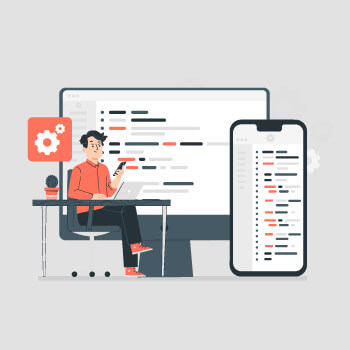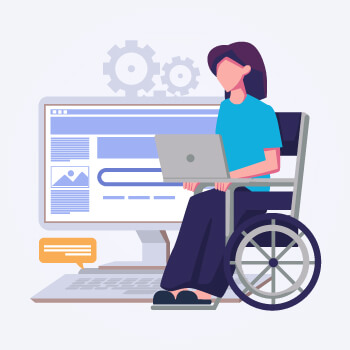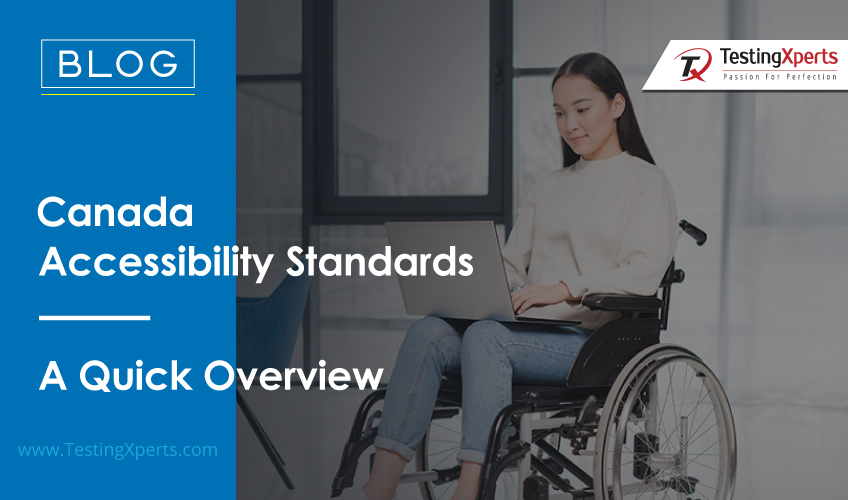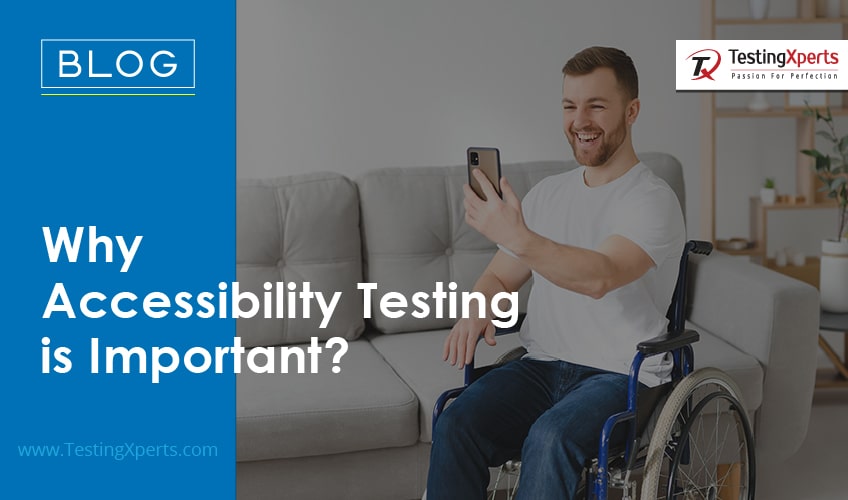
- Why Automated Accessibility Testing is Important for Businesses?
- Multi-Platform Challenges and Solutions
- How Automated Accessibility Testing Enhances User Experience?
- Overall Impact of Accessibility Testing on User Experience
- Conclusion
- How can TestingXperts help you with Automated Accessibility Testing?
The digital world is rapidly progressing, and automation is a moral necessity to ensure a positive user experience. Traditional manual accessibility testing expends a considerable amount of time and resource, while also leaving space for missed bugs and issues spotting due to inevitable human errors. This is where automated accessibility testing plays a crucial role – in identifying and resolving accessibility issues.
In testing of accessibility, the importance of automated testing instruments, their capacities in adhering to principles, e.g. the Web Content Accessibility Guidelines (WCAG), and how they add to web biological community that prioritizes statistical convenience is done.
Why Automated Accessibility Testing is Important for Businesses?

Automated accessibility testing is vital for organizations dedicated to offering inclusive digital experiences. In today’s world, online presence is essential as it confirms that sites and applications are accessible to clients of all capacities. It is not simply a legal necessity but a critical strategic objective. Automated testing instruments give organizations a scalable and productive method for recognizing and tending to accessibility issues all through the improvement process. By automating these tests, organizations can streamline their workflows, reduce development time, and minimize the risk of overlooking critical accessibility considerations.
Moreover, as the worldwide market becomes increasingly diverse, accessibility is a crucial factor in broadening reach and connecting with a more extensive crowd. Investigations demonstrate that shoppers are more prone to involve with and trust organizations that need comprehensiveness. Fundamentally, automated accessibility testing is not precisely a consistency check-box; it is a process that improves proficiency, comprehensiveness, and brand image in a consistently evolving digital environment.
Here are some of the major benefits of Accessibility Testing for Businesses Listed:
Expanded Market Reach
Approximately 15% of people globally live with disabilities, according to the World Health Organization. By designing digital assets to be accessible, businesses can potentially reach over a billion customers who may face obstacles. Therefore, companies that emphasize accessibility testing can attract a broader customer base by confirming their digital products and services are usable for individuals with diverse capabilities.
Enhanced User Engagement and Satisfaction
A research by the WebAIM Million analysis detected that over 98% of the top one million home pages had accessibility issues that failed to meet WCAG 2 standards. By tackling these problems through accessibility testing, companies can boost user happiness and keep customers, as 88% of online buyers are less likely to return to a site after a poor experience. Thus, addressing accessibility can result in improved user experiences, cultivating greater customer pleasure and allegiance.
Risk Mitigation and Legal Compliance
The quantity of online accessibility-related legal actions has increased, with a 23% rise in 2020 compared to the preceding year. By preemptively resolving accessibility issues through testing, businesses can lessen the chance of lawful disputes, safeguarding their reputation and economic security. Doing so helps businesses mitigate the risk of legal consequences related to inaccessible digital content and ensure adherence to accessibility regulations.
Multi-Platform Challenges and Solutions

Ensuring usability across different digital platforms and devices is a complex task for companies today. While automated testing helps evaluate accessibility, it faces unique obstacles with multiplatform creation. This article examines the difficulties in guaranteeing usability across diverse environments, and recommends approaches to handling these intricacies.
Problem Area |
Challenge |
Solution |
|
Integration with Development Workflows |
Integrating automated accessibility testing seamlessly into diverse development workflows, including web, mobile, and desktop, can be complex and time-consuming.
|
Opt for testing tools that integrate well with popular development environments and continuous integration/continuous deployment (CI/CD) pipelines. This ensures that accessibility testing becomes an integral part of the development lifecycle, reducing the risk of accessibility issues creeping in at later stages.
|
|
Native App Accessibility
|
Ensuring accessibility in native mobile applications poses unique challenges, as automated tools developed for web environments may not be directly applicable.
|
Utilize specialized automated testing tools designed for native mobile platforms. These tools can assess mobile-specific accessibility features and provide insights into how users with disabilities interact with mobile applications.
|
|
Platform Diversity Challenges
|
Different platforms (web, mobile, desktop) often have distinct accessibility requirements and guidelines, making it challenging to maintain consistency in testing.
|
Implement a comprehensive testing strategy that incorporates specialized tools for each platform, ensuring adherence to platform-specific accessibility standards. This approach ensures that the user experience is consistently accessible across various devices and interfaces.
|
|
Responsive Design and Dynamic Content
|
Responsive design and dynamic content can present challenges for automated tools, as they may struggle to accurately assess accessibility in real-time or across various screen sizes.
|
Combine automated testing with manual testing to address dynamic content effectively. Implement automated testing tools that support responsive design testing and leverage scripting for dynamic elements. Additionally, consider using real user monitoring to capture actual user experiences across different platforms.
|
|
Cross-Browser Compatibility
|
Variations in browser behavior can impact the consistency of accessibility features, necessitating testing across multiple browsers.
|
Select automated testing tools that support cross-browser compatibility testing. This ensures that accessibility features are consistent across different browsers, providing a uniform experience for users regardless of their chosen browser.
|
How Automated Accessibility Testing Enhances User Experience?

Making websites easy for all people to use benefits everybody. Companies that make accessibility a priority show they care about including everyone. By creating digital spaces that follow guidelines but feel natural and work well, they welcome a large diverse group of visitors. People appreciate efforts to be inclusive, which helps businesses succeed.
Inclusive Design Fosters User Satisfaction
Accessibility initiatives focus on inclusive design principles, ensuring that digital experiences cater to users with diverse abilities. By accommodating a wide range of needs, businesses create a more welcoming and user-friendly environment, leading to increased user satisfaction.
Improved Navigation for All Users
Accessible design often involves clear and logical navigation structures. While this is crucial for users with disabilities, it benefits all users by making interfaces more intuitive and efficient. Well-structured navigation enhances the overall user experience by reducing confusion and streamlining the user journey.
Enhanced Usability Across Devices
Accessibility measures often result in responsive and adaptable designs, ensuring that content is accessible on various devices and screen sizes. This not only accommodates users with disabilities who may use different assistive technologies but also provides a consistent and enjoyable experience for all users, regardless of the device they choose.
Faster Loading Times and Performance
Optimizing accessibility often involves improving the underlying code and content structure. These optimizations can contribute to faster loading times and improved performance. This not only benefits users with slower internet connections or limited bandwidth but also enhances the overall user experience for everyone by delivering content more swiftly.
Positive Impact on Brand Reputation
Ensuring accessibility shows positive dedication to inclusion. Consumers value brands that prioritize diversity, and this commitment can contribute to an excellent public image. According to a WebAIM study, 71.3% of users with disabilities will leave a website that is not accessible, highlighting the effect of accessibility on how consumers perceive brands and their reputation.
Overall Impact of Accessibility Testing on User Experience

The effects of accessibility testing on user experience are profound and far reaching. Accessibility testing guarantees that digital environments are inclusive and inviting to users of all capabilities, contributing to a more equitable online experience. By recognizing and correcting hurdles that may impede access for individuals with disabilities, businesses enhance the usability of their digital products and services for everyone. This approach of including all people aligns with the principles of universal design, generating interfaces that are not simply accessible but also intuitive and user friendly for diverse people.
Accessibility testing helps create smooth and fast experiences for everyone using an interface. When interfaces are designed with accessibility in mind, users have easy navigation and quick loading. They can also interact seamlessly. Accessibility testing eliminates potential frustrations from content some cannot access. This makes for a positive experience for all users. Businesses that focus on accessibility testing not just meet legal rules but build user-centric approaches. These lead to users feeling satisfied, seeing the brand positively, and more people using it. In other words, accessibility testing transforms user experience. It encourages diversity, fairness, and usability for everyone in the digital world.
Conclusion
By empowering organizations with automated accessibility screening, companies place themselves at the vanguard of user-focused design, cultivating a digital space where usability understands no boundaries. The advantages stretch beyond mere conformance to standards; they reverberate with patrons, elevating fulfillment, allegiance, and brand perspective.
As organizations navigate the complexities of multi-channel difficulties and appreciate the achievements, it turns out to be evident that automated accessibility testing isn’t simply an innovative advancement. It is a responsibility to comprehensiveness and an announcement of an organization’s obligation to giving an automated encounter that is genuinely smooth for everybody. Organizations that embrace automated accessibility testing take steps towards digital inclusivity. This allows users with diverse abilities to explore, interact, and benefit from digital experiences without barriers.
How can TestingXperts help you with Automated Accessibility Testing?

• TestingXperts, as a testing services provider, offer comprehensive Automated Accessibility Testing services to ensure that your digital assets are inclusive and compliant with accessibility standards. Here are ways in which we can assist you:
• Our team of seasoned professionals is well-versed in the latest accessibility guidelines and best practices. This expertise ensures that your digital products meet the required accessibility standards, reducing legal risks and enhancing user satisfaction
• Our in-house accelerator, Tx-Automate, streamlines the testing process, allowing for rapid and accurate identification of accessibility issues. Tx-Automate speeds up the testing cycle and ensures a more thorough and consistent testing process.
• Our Automated Accessibility Testing covers various disabilities, including visual, auditory, physical, speech, cognitive, and neurological. This comprehensive approach ensures no user is left behind, making your product inclusive.
• TestingXperts stays ahead of the curve, ensuring that your products are compliant today and continue to meet accessibility standards as they evolve.
• We prioritize the end-user experience in our testing methodologies. Focusing on real-world usability ensures that accessibility improvements are practical and enhance the overall user experience.
• Understanding that each client has unique needs, we offer tailored testing strategies. This customization ensures that our solutions align perfectly with your requirements and goals.
To know more, contact our QA experts now.
Discover more
Get in Touch
Stay Updated
Subscribe for more info



